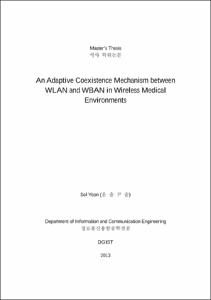Full metadata record
| DC Field | Value | Language |
|---|---|---|
| dc.contributor.advisor | Park, Kyung Joon | - |
| dc.contributor.author | Yoon, Sol | - |
| dc.date.accessioned | 2017-05-10T08:50:09Z | - |
| dc.date.available | 2016-05-18T00:00:00Z | - |
| dc.date.issued | 2013 | - |
| dc.identifier.uri | http://dgist.dcollection.net/jsp/common/DcLoOrgPer.jsp?sItemId=000002262504 | en_US |
| dc.identifier.uri | http://hdl.handle.net/20.500.11750/1339 | - |
| dc.description.abstract | Electronic health (E-Health) is being recognized as a method to improve the overall health status of the population. For this reason, medical wireless communication technology has been actively studied to realize E-health. Unlike wired communication, the use of wireless communication remains to provide ubiquitous connectivity; it allows better access and enables greater physical mobility to patients. Among the various wireless technologies, WLAN (IEEE802.11/WiFi) and WBAN (IEEE 802.15.4/ZigBee) are widely used for e-healthcare system. However, interoperability and coexistence between these two heterogeneous networks are becoming key issues. ZigBee is potentially vulnerable to interference by WiFi in the same unlicensed ISM band. Most of all, the significantly different power level and asynchronous time slots result in significant unfairness between WLAN and WBAN. In this thesis, we focus on the coexistence environment beween WLAN and WBAN for e-healthcare systems in the ISM band. We propose an adaptive coexistence CSMA mechanism which can mitigate interference and achieve efficiency channel sharing. By using an efficient throughput model, we control and find an appropriate adaptive contention window size of WLAN in order to give transmission opportunities to WBAN. This proposal can guarantee the required medical-grade QoS of WBAN without any significant degradation of the throughput of WLAN. The simulation results using MATLAB confirm that the proposed algorithm operate to make efficient channel sharing compare with conventional approach. As a result, the proposed coexistence CSMA protocol guarantee reliable healthcare system and provide better QoS of WLAN and WBAN in medical environments. ⓒ 2013 DGIST |
- |
| dc.description.tableofcontents | I. INTRODUCTION 1-- II. RELATED WORK 4-- 2.1 Collision of ZigBee and WiFi 4-- 2.2 Existing Coexistence Mechanisms 5-- III. BACKGROUND 7-- 3.1 Wireless Networking in Healthcare 7-- 3.2 IEEE 802.11 WLAN 9-- 3.2.1 Physical Layer 9-- 3.2.2 MAC Layer 11-- 3.3 IEEE 802.15.4 for WBAN 13-- 3.3.1 Physical Layer 14-- 3.3.2 MAC Layer 15-- IV. PROBLEM STATEMENT 17-- 4.1 Critical Data Transmission Issue in WBAN 18-- 4.2 Asymmetry of Carrier Sensing 18-- 4.3 Collision due to Different Response Time 20-- 4.4 Preliminary Simulation 21-- V. PROPOSED ALGORITHM 25-- 5.1 Throughput Model per System 25-- 5.2 Optimal Contention Window Size 28-- VI. SIMULATION 31-- VII. CONCLUSION 37-- REFERENCES 39 |
- |
| dc.format.extent | 42 | - |
| dc.language | eng | - |
| dc.publisher | DGIST | - |
| dc.subject | Wireless Local Area Network (WLAN) | - |
| dc.subject | Wireless Body Area Network (WBAN) | - |
| dc.subject | Coexistence | - |
| dc.subject | E-health | - |
| dc.subject | CSMA | - |
| dc.subject | 공존성 | - |
| dc.subject | 무선랜 | - |
| dc.subject | 무선 신체 영역 네트워크 | - |
| dc.title | An Adaptive Coexistence Mechanism between WLAN and WBAN in Wireless Medical Environments | - |
| dc.title.alternative | 무선 의료 환경을 위한 WLAN 과 WBAN 의 적응 공존 기법 | - |
| dc.type | Thesis | - |
| dc.identifier.doi | 10.22677/thesis.2262504 | - |
| dc.description.alternativeAbstract | 최근, 고령 인구의 증가와 만성 질환 환자의 증가로 인해 E-health 의 중요성이 강조되고 있다. 특히, E-health 를 실현시키기 위해 다양한 의료 무선 통신이 활발히 연구 중이다. 의료 환경 내에서 기존의 유선 통신과 다르게 무선 통신의 사용은 환자들에게 이동성을 보장하고 동시에 의료 서비스의 품질을 높일 수 있다는 장점이 있다. 본 논문에서 초점을 맞추고 있는 WLAN (IEEE802.11/WiFi)와 WBAN (IEEE 802.15.4/ZigBee)은 다양한 무선 통신 기술 중 의료환경 및 가정 환경 내에서 가장 널리 사용되는 통신 기술이다. 하지만 WiFi 와 ZigBee 의 경우 동일한 2.4 GHz ISM 주파대역을 사용함에 따라 두 시스템간 전송 세기의 차이로 인해 공존성 문제가 발생하게 된다. WiFi 는 상대적으로 전송 세기가 낮은 ZigBee 의 전송을 인지하지 못하고 ZigBee 가 전송하고 있는 도중 전송을 시작하며 그 결과, ZigBee 는 WiFi 로부터 간섭을 받아 전송을 실패하게 된다. 이러한 상황은 의료 환경에서 실시간으로 패킷을 전송하고 QoS 를 보장 받아야 하는 WBAN 에게 매우 치명적일 수 있다. 따라서 본 논문에서는 효율적인 채널 쉐어링을 제공하는 CSMA 매커니즘을 제안한다. 일반적인 무선통신망과는 달리, 의료 무선 통신망에서는 WBAN 의 전송을 보장하되 WLAN 이 나머지 시간을 효율적으로 활용하는 것이 목적이다. 이 매커니즘은 전체적인 시스템의 상황에 맞게 WLAN의 contention window 크기를 조절하여 WBAN 에게 전송기회를 부여하는 방법으로서 WBAN 의 전송을 보장하는 범위에서 WLAN 의 throughput 을 최대화시킴으로써 WLAN 과 WBAN 의 효율적인 공존을 실현시킬 수 있다. 다양한 시뮬레이션을 통하여, WBAN 의 전송이 보장되는 동시에 WLAN 의 throughput 이 증가하는 결과를 확인할 수 있었다. 본 논문에서 제안한 공존 매커니즘은 의료 무선통신 망의 신뢰성을 향상시키고 QoS 를 보장하여 보다 높은 품질의 의료서비스를 제공할 수 있으리라 예상된다. ⓒ 2013 DGIST |
- |
| dc.description.degree | Master | - |
| dc.contributor.department | Information and Communication Engineering | - |
| dc.contributor.coadvisor | Lee, Sung Bae | - |
| dc.date.awarded | 2013. 8 | - |
| dc.publisher.location | Daegu | - |
| dc.description.database | dCollection | - |
| dc.date.accepted | 2016-05-18 | - |
| dc.contributor.alternativeDepartment | 대학원 정보통신융합공학전공 | - |
| dc.contributor.affiliatedAuthor | Yoon, Sol | - |
| dc.contributor.affiliatedAuthor | Park, Kyung Joon | - |
| dc.contributor.affiliatedAuthor | Lee, Sung Bae | - |
| dc.contributor.alternativeName | 윤솔 | - |
| dc.contributor.alternativeName | 박경준 | - |
| dc.contributor.alternativeName | 이성배 | - |
- Files in This Item:
-
 기타 데이터 / 583.17 kB / Adobe PDF
download
기타 데이터 / 583.17 kB / Adobe PDF
download
- Appears in Collections:
- Department of Electrical Engineering and Computer Science Theses Master



